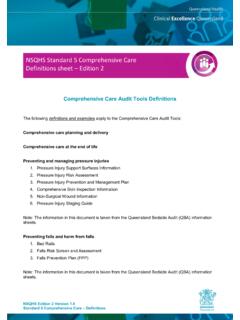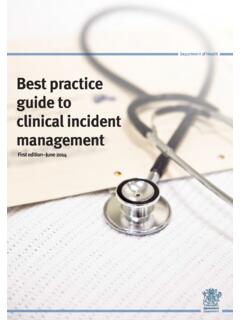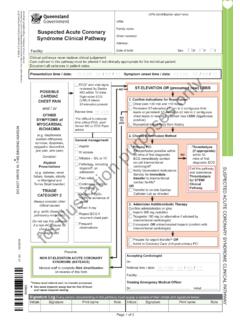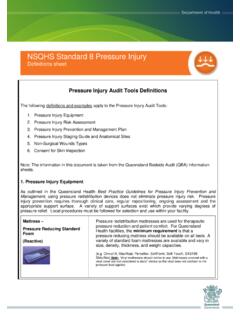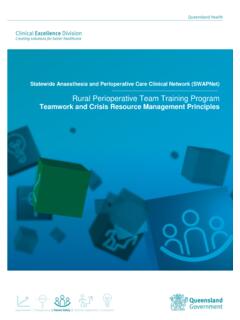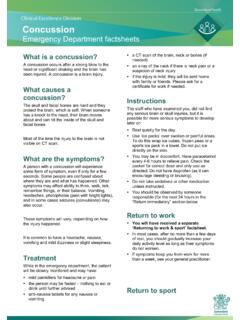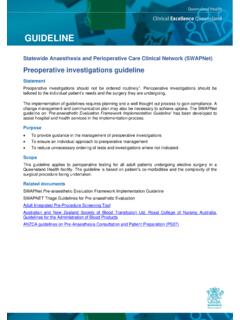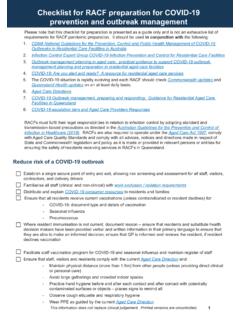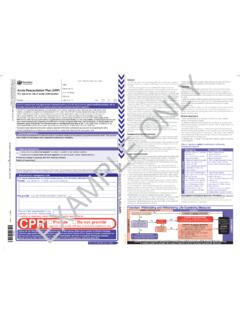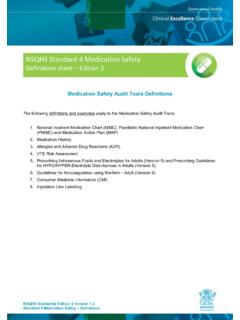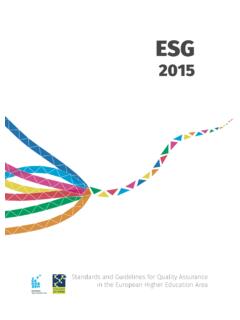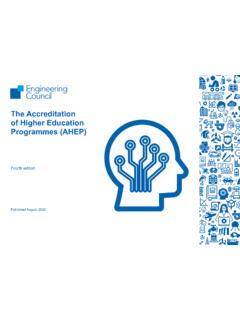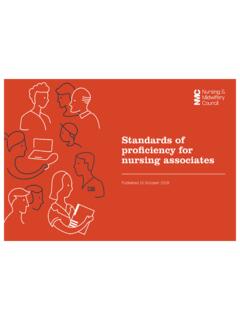Transcription of NSQHS Standards - Standard 8 Recognising and …
1 NSQHS Standards Edition 2 Version Standard 8 Recognising and responding to acute deterioration Definitions Recognising and responding to acute deterioration Audit Tools Definitions The following definitions and examples apply to the acute deterioration Audit Tools: 1. Observation chart a. Combination system, Q-ADDS, CEWT, Q-MEWT, NEWT b. Single parameter tool (track and trigger) c. Non track and trigger, non scoring system 2. National Consensus Statement: essential elements for Recognising and responding to acute physiological deterioration . 1. Observation Chart Ensuring that patients who deteriorate receive appropriate and timely care is a key safety and quality challenge.
2 Early identification of deterioration may improve outcomes and lessen the intervention required to stabilise patients whose condition deteriorates in a health service. The warning signs of clinical deterioration are not always identified or acted on appropriately. Systems to recognise deterioration early and respond to it appropriately need to apply across the health service organisation. The objective of an observation chart is to present the most important vital signs for detecting deterioration in most patients in a user-friendly manner. One of its specific aims is to detect deterioration early and to assist with early management. Most Queensland Health facilities use the Queensland Adult deterioration Detection System (Q-ADDS), Children s Early Warning Tool (CEWT) or the Queensland Maternity Early Warning Tool (Q-MEWT) which meet action of the NSQHS Standards Edition 2.
3 There are a few facilities that use their own observation chart and examples are provided below to assist to assist you in determining which tool your facility/ward uses. NSQHS Standard 8 Recognising and responding to acute deterioration Definitions sheet Edition 2 NSQHS Standards Edition 2 Version Standard 8 Recognising and responding to acute deterioration Definitions - 2 - Combination system (scoring, track and trigger) A single or multiple parameter (track and trigger) system(s) used in combination with aggregate weighted scoring system. Vital signs are graphed (dot with connecting lines) and trends tracked and each vital sign attracts a score depending on its value, this is highlighted by a colour zone and the scoring legend.
4 The vital signs scores are added to calculate a Total score for the set of vital signs. There are actions/responses according to Total score. In addition to the scoring system, the tool also incorporates a single track and trigger system (purple rows) which mandate clinicians to initiate an emergency response, independent of the Total Score. Q-ADDS Adult deterioration Detection System Scores for all physiological parameters are summed up to obtain a total score NSQHS Standards Edition 2 Version Standard 8 Recognising and responding to acute deterioration Definitions - 3 - Combination system (scoring, track and trigger) CEWT Children s Early Warning Tool ( released September 2018) Q-MEWT Queensland Ante-natal Maternity Early Warning Tool Q-MEWT Queensland Post-natal Maternity Early Warning tool Modified Early Warning Score (MEWS) general observation chart [TPCH] Adult Modified Early Warning Score (MEWS)
5 Vital signs record [TTH] area for recording Total score area for recording Total score area for recording Total score area for recording Total score area for recording Total score NSQHS Standards Edition 2 Version Standard 8 Recognising and responding to acute deterioration Definitions - 4 - Combination system (scoring, track and trigger) NEWT Neonatal Early Warning Tool (for facilities with an onsite nursery/NICU) NEWT Neonatal Early Warning Tool (for facilities without an onsite nursery/NICU) Single parameter tool (track and trigger) The main vital signs are graphed with trends tracked . There are colour coded zones to indicate when a patient s vital signs trigger a response.
6 MECC (Medical emergency call criteria) [RBWH] Non-track and trigger, non-scoring system Other observation charts may include the collection of vital signs with no scoring or no criteria for a response. Observations may or may not be graphed. area for recording Total score NSQHS Standards Edition 2 Version Standard 8 Recognising and responding to acute deterioration Definitions - 5 - 2. National Consensus Statement: essential elements for Recognising and responding to acute physiological deterioration Question on the patient audit tool focus on documentation in the patient s healthcare record that the National consensus statement: essential elements for Recognising and responding to acute physiological deterioration outlines as important in the event that the patient has an emergency call placed.
7 NSQHS Standards Edition 2 Version Standard 8 Recognising and responding to acute deterioration Definitions - 6 - References: National Consensus Statement: essential elements for Recognising and responding to acute physiological deterioration , Second edition, 2017, Further information can be found at: Australian Commission on Safety and Quality in Health Care Website: Queensland Health staff can access information on Recognising and responding to acute deterioration via the Queensland Health intranet Patient Safety and Quality Improvement Service website. NSQHS Standards Edition 2 Version Standard 8 Recognising and responding to acute deterioration Definitions - 7 - State of Queensland (Queensland Health) 2018 This document is licensed under a Creative Commons Attribution Australia licence.
8 To view a copy of this licence, visit You are free to copy, communicate and adapt the work for non-commercial purposes, as long as you attribute the State of Queensland (Queensland Health). For further information contact Patient Safety and Quality Improvement Service, Clinical Excellence Queensland, Department of Health, PO Box 2368, Fortitude Valley BC, Qld 4006, email phone (07) 3328 9430. For permissions beyond the scope of this licence contact: Intellectual Property Officer, Department of Health, GPO Box 48, Brisbane Qld 4001, email We recognise and appreciate that there may be gaps in the scope and questions included in these tools, however, as the audit tools are a constant Work in Progress , future versions will build upon the existing scope and questions, and incorporate staff feedback and suggestions for improvement.
9 Patient Safety and Quality Improvement Service, Clinical Excellence Queensland, welcomes feedback on the audit tools and the measurement plans, to ensure the tools meet the needs of Queensland Health facilities. We appreciate any feedback you can provide for the next version. Please email Patient Safety and Quality Improvement Service on for feedback or comments.
